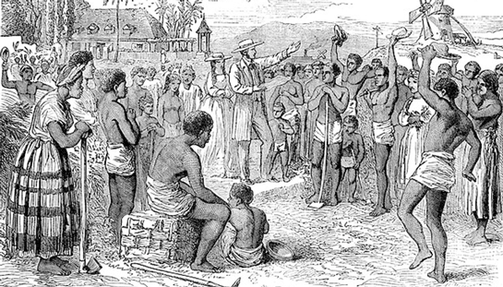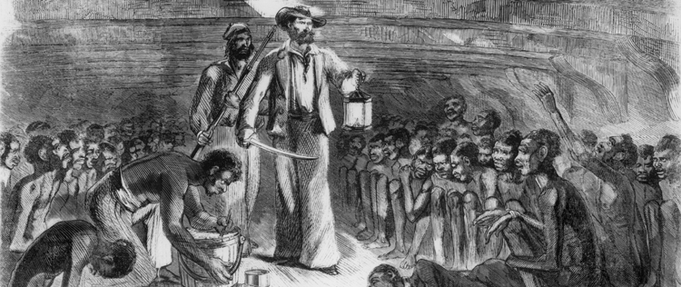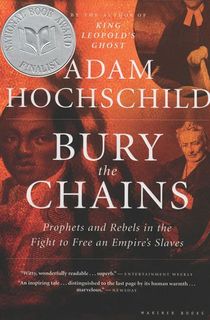While slavery in Britain existed in various forms before the Roman occupation of the island during the early part of the Common Era, most discussions of slavery in Britain actually refer to the British Empire’s contributions to the Atlantic slave trade, in which enslaved African peoples were transported to the Americas for forced labor.
Furthermore, slavery on the soil of the British Isles itself was quite a different matter from slavery within the larger British Empire during its height. While a 1722 court case found that slavery was not recognized by English law, slavery continued in British territories until as late as 1937.
Britain and the Atlantic Slave Trade
“The hinge on which all the trade of this globe moves”
Unfortunately, the kidnapping, trafficking, and enslavement of individuals from Africa had been going strong for centuries before the British Empire got involved. “The African continent was bled of its human resources via all possible routes,” Elikia M’bokolo wrote in Le Monde diplomatique in 1998. “Across the Sahara, through the Red Sea, from the Indian Ocean ports and across the Atlantic.”
These institutions of human misery had existed since antiquity, and continued in various forms into the 19th century. Historians often divide the Atlantic slave trade, specifically, into eras known as the first and second Atlantic systems. The second Atlantic system was when the British became heavily involved. By the 1690s, the British were one of the largest shippers of enslaved people from West Africa, and James Houston, an English slave trader, called slavery “the hinge on which all the trade of this globe moves.”
While the Atlantic slave trade had existed for centuries, it is estimated that more than half of all the slave trade along this route took place in the 1700s, with enslaved Africans brought to the Americas to perform forced labor, especially on farms and plantations throughout present-day Mexico, the Caribbean, and what is now the American South. Many of these plantations and farms existed in British colonies, where enslavers relied on this inexpensive labor to maintain their profits.
“So odious that nothing can be suffered to support it”
James Somerset was born in West Africa and captured and sold into slavery when he was around eight years old. He was transported to the Colony of Virginia, where he was bought by a Scottish merchant named Charles Stewart.
In 1769, Stewart returned to England, bringing Somerset with him. In 1771, Somerset was baptized at the Church of St. Andrew, Holborn. Not long after, he fled his captor and lived in freedom for two months before being caught and imprisoned on a ship called the Ann and Mary, where he was to be transported to Jamaica and sold.
The godparents who had sponsored his baptism brought his case before the courts. The case ultimately determined that slavery was not recognized by English law, with Lord Mansfield stating that “it is so odious, that nothing can be suffered to support it, but positive law. Whatever inconveniences, therefore, may follow from the decision, I cannot say this case is allowed or approved by the law of England; and therefore the black must be discharged.”
The Abolition Movement in Britain
“Am I not a man and a brother?”
Abolition movements had existed for as long as the slave trade, but Lord Mansfield’s decision in Somerset v Stewart gave the abolition movement in England new ammunition. Granville Sharp had helped to bring Somerset’s case before the court, and he was one of the twelve men who, in 1787, founded the Society for Effecting the Abolition of the Slave Trade in a print shop at 2 George Yard in London, as chronicled in Adam Hochschild’s book Bury the Chains.
“In 1787,” Hochschild writes for the BBC, “approximately three-quarters of the people on Earth lived under some form of enslavement, serfdom, debt bondage or indentured servitude. There were no slaves in Britain itself, but the vast majority of its people accepted slavery in the British West Indies as perfectly normal.”
The twelve men who formed what was often called the Abolition Society were not among that “vast majority.” They were lawyers, clergymen, printers, and others, all of whom were determined to bring an end to the slave trade in Britain. Josiah Wedgwood was not one of the twelve founding members. Still, nonetheless, his contribution to the Abolition Society was a historic one, as he created a range of pottery medallions bearing an image of a kneeling enslaved person with the words, “Am I not a man and a brother?”
Called “the most famous image of a black person in all of 18th-century art,” these Wedgwood medallions found their way into everyday life and helped to promote the cause of the Abolition Society. “Ladies wore them in bracelets,” wrote Thomas Clarkson, one of the founders of the Abolition Society, “and others had them fitted up in an ornamental manner as pins for their hair. At length the taste for wearing them became general, and thus fashion, which usually confines itself to worthless things, was seen for once in the honourable office of promoting the cause of justice, humanity and freedom.”
“The stream of popularity runs against us”
The Abolition Society has been called the model on which all modern social movements are built. It made use of many techniques familiar to us today, including consumer boycotts, pamphlets, lecture tours, and celebrity endorsements. And it worked. “The Press teems with pamphlets upon this subject, and my table is covered with them,” reported Stephen Fuller, a London agent for Jamaican enslavers. “The stream of popularity runs against us.”
In 1807, Parliament passed the Slave Trade Act, which outlawed the slave trade in Britain, but not slavery itself. Slavery would not be officially abolished by British law until 1833, when Prime Minister Charles Grey legislated the Slavery Abolition Act.

Enslaved people on a British plantation in the West Indies receiving news of their emancipation (1873-5).
Photo Credit: Wikimedia CommonsWhen Did Slavery in Britain End?
In 1807, Parliament passed the Slave Trade Act, which outlawed the slave trade in Britain, but not slavery itself. Slavery would not be officially abolished by British law until 1833, when Prime Minister Charles Grey legislated the Slavery Abolition Act.
However, not even the Slavery Abolition Act truly ended slavery in the British Empire. While enslaved people below the age of six were freed, formerly enslaved people who were older than six found themselves redesignated as “apprentices,” with servitude that only gradually came to an end over subsequent years. Further, certain territories were explicitly excluded from the law, and while the act paid enslavers restitution, the enslaved people themselves were not.
Over subsequent decades, further acts and laws would continue to chip away at the practice and trade of enslaved people throughout the British Empire, until the last British territories finally abolished slavery in 1937, more than one hundred years after the Slavery Abolition Act was passed by parliament.
Featured image: The Everett Collection / Canva

